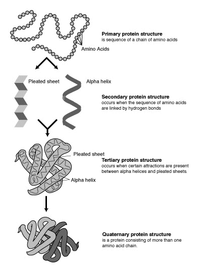
Photo from wikipedia
The use of fragment libraries is a popular approach among protein structure prediction methods and has proven to substantially improve the quality of predicted structures. However, some vital aspects of… Click to show full abstract
The use of fragment libraries is a popular approach among protein structure prediction methods and has proven to substantially improve the quality of predicted structures. However, some vital aspects of a fragment library that influence the accuracy of modeling a native structure remain to be determined. This study investigates some of these features. Particularly, we analyze the effect of using secondary structure prediction guiding fragments selection, different fragments sizes and the effect of structural clustering of fragments within libraries. To have a clearer view of how these factors affect protein structure prediction, we isolated the process of model building by fragment assembly from some common limitations associated with prediction methods, e.g., imprecise energy functions and optimization algorithms, by employing an exact structure-based objective function under a greedy algorithm. Our results indicate that shorter fragments reproduce the native structure more accurately than the longer. Libraries composed of multiple fragment lengths generate even better structures, where longer fragments show to be more useful at the beginning of the simulations. The use of many different fragment sizes shows little improvement when compared to predictions carried out with libraries that comprise only three different fragment sizes. Models obtained from libraries built using only sequence similarity are, on average, better than those built with a secondary structure prediction bias. However, we found that the use of secondary structure prediction allows greater reduction of the search space, which is invaluable for prediction methods. The results of this study can be critical guidelines for the use of fragment libraries in protein structure prediction.
Journal Title: PLoS ONE
Year Published: 2017
Link to full text (if available)
Share on Social Media: Sign Up to like & get
recommendations!